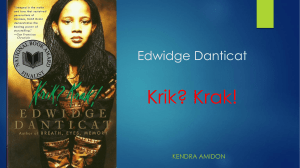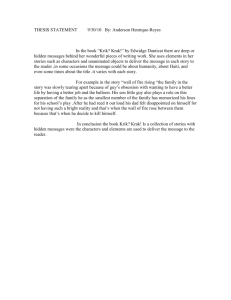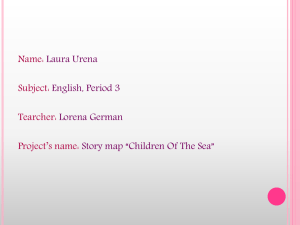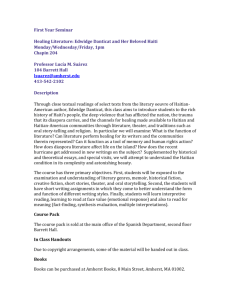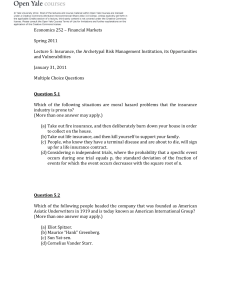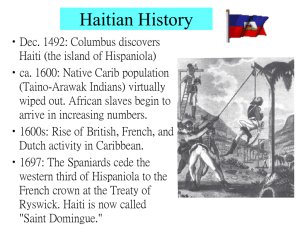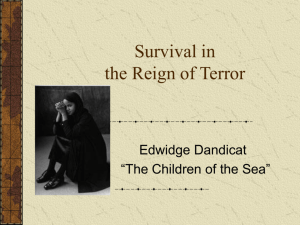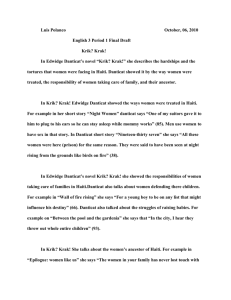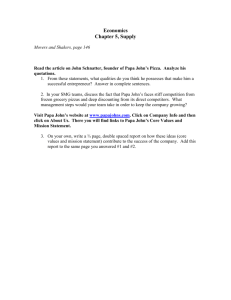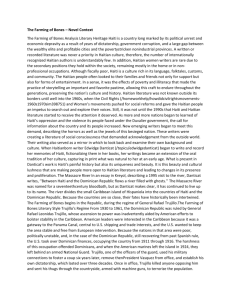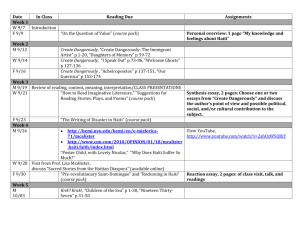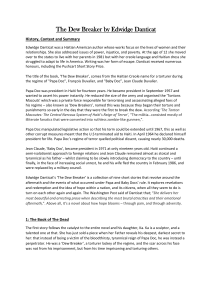Children of the Sea
advertisement
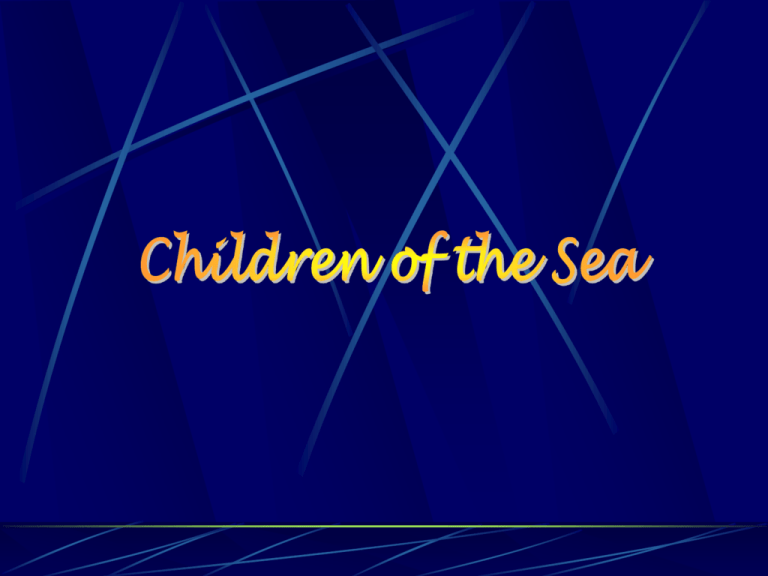
Author~Edwidge Danticat Birth-Port-au-Prince, Haiti January 19, 1969 Emigration-Brooklyn, New York 1981 Study-Barnard College for French Literature 1990, Brown College for Fine Art 1993 Writing of the Author Beginning, 1978 Breath, Eyes, Memory, 1994 Kric? Krac! 1995 Farming of the Bones, 1998 Kric? Krac! “Kric” and “Krac” A weaver of tales “I wanted to raise the voice of a lot of the people that I knew growing up, and this was, for the most part, . . . poor people who had extraordinary dreams but also very amazing obstacles." CRITICAL EXTRACTS CARRIBBEAN WOMEN WRITERS (1) Ingrid Sturgis (2) Ellen Kanner (3) Jordana Hart (4) Erika J. Waters INGRID STURGIS (I) “<…>Krik? Krak!, chronicles the ups and downs of Haitian life. A complication of masterful storytelling, it reveals the harsh life under dictatorship, the reign of terror by the strong-arm forces, the Tonton Macoutes. The sometimes metaphorical stories are filled with tales of Haitian rituals and legends that resonate with truth and poetry. INGRID STURGIS (II) Make no mistake, these lyrical stories are powerful and political works of art. Unlike Breath, Eyes, Memory, Danticat says ‘The stories are more of a collective biography. I know someone it happened to or might have happened to. It’s a lot of people’s stories.’” ELLEN KANNER “In many ways, each of these 10 stories (in Krik? Krak!) is part of the same tale. Women lose who and what they love to poverty, to violence, to politics, to ideals. The author’s deceptively artless stories are not of heroes but of survivors, of the impulse toward life and death and the urge to write and to tell in order not to forgot.” JORDANA HART “More than anything else, the storytelling of the young Haitian-American writer Edwidge Danticat has given the world honest and loving portraits of Haitian people, both on the island and in the United States. She has smashed the numbing stereotype created by a barrage of media accounts of Haitian poverty, misery, and death. <…>” ERIKA J. WATERS(I) “One of Danticat’s strengths is her irony, subtle and penetrating.” <…> “While watching the young woman clutch her dead baby in the “Children of the Sea,” the narrator takes the time to record that her friend has passed university. Danticat shows here how desperately humankind clings to the myths and belief of civilized society. ERIKA J. WATERS(II) Irony is further enhanced by the use of “krik krak” as the title. While that is the standard ending (sometimes opening) for a Caribbean story, the stories are usually anancy stories and folktales with moral lessons. Danticat’s nightmarish tales are a far cry from those, but he tales do carry a moral lesson – about the powerful and the powerless, about the failure of food to triumph over evil.” Haitian History The name of Haiti means mountainous country which was given by the former TainoArawak people. Chronology 1 1492 ~1600 Columbus discovered Haiti. Spanish conquered Hispaniola. 1697 Spanish ceded the domination of Haiti to French. 1697~1791 The richest colony in the world Chronology 2 1791 the first major black rebellion took place. 1796 the former slaves prevailed under the leadership of Toussaint L’Ouverture 1804 the Republic of Haiti Chronology 3 ~1820 The failed dictatorship 1915~1934 The US invaded Haiti for 19 years 1957 Francois Duvalier “Papa Doc” became the president. Chronology 4 1971 Duvalier died and his son Jean- Claud “Baby Doc” succeed. 1972 Arrival of “boat people” in Florida. Haitian Culture ‧People -Divisions of race and class between blacks(about 95% of population) and mulattos(about 5%) ‧Language -Nearly all blacks speak Creole -French is spoken mainly by the mulatto elite, and is the official language. Haitian culture(2) ‧Home of Voodoo -An animistic African religion that has been melded with Catholicism -80% people believe in Catholicism and 5% people are Protestant;Voodoo is popular among the farming society Haitian Culture(3) -Rituals involve dancing and drumming,spirit possessions and the occasional zombie. -Iwa(the spirit worshipper is chosen to be ‘mounted’ by a spirit) The commercial heart of Port-au-Prince Couple fishing Rice Farmer Waiting for food Voodoo Festival Relationship of the characters Parents | Kompe -(the radio six) Parents | Madam Roger girl (nameless) boat people– Celianne, an old man Q:Why is the female leading character nameless? Is there any special meaning? A:We can have much more space to exercise our imagination. Or her name only means to Kompe.(p3) About Kompe ※Self-pride:bathroom(p15), crying(p9) ※Identification: One may lose one’s identification on the boundless sea (p9, 11) Major themes Hope (or hopelessness) Love Religion:Christian, Agwe Tyranny The topic:Children of the Sea(p27) Q:How do people react to tragedy,calamity, brutality in the story? A: Father—powerless(p17); Kompe—escape; Madam Roger—resist(p16) Q:What do you think about the ending of the story?What are the attitudes toward the future?Do they have hope? Q:Why did the baby of Celianne, Swiss,not cry at all on the boat? Technique Narrative form Objectification:fiery red ant (p3), crushed snail(p3) ---- leading female role; dog(p8)---- the macoutes; vulture(p8 & p18)---- the macouts, Kompe and other boat people Simile (p22, 25, 26, 27) Kompe’s Dream(I) i. Do you remember our silly dreams? Passing the university exams and then studying hard to go until the end, the farthest of all we can go in school. (p.21) Kompe’s Dream(II) ii. I dream that we are caught in one hurricane after another. I dream that winds come of the sky and claim us for the sea. We go under and no one hears from us again. (p.6) iii. The other night I dream that I died and went to heaven. This heaven was nothing like I expected. It was at the bottom of the sea. (p. 11-12) Repeat (I) Her whole family did not want her to marry papa because he was a gardener from Ville rose and her family was from the city and some of them had even gone to university (p. 22) Papa worries a little about you. He doesn't hate u as much as you think. The other day I heard him asking manman, do u think the boy is dead? Manman said she didn't’t know. I think he regrets being so mean to you. (p. 5) Repeat (II) Papa rejects Kompe as Manman’s family rejects papa. Manman’s (family) (from the city) (high social status) | Papa (a gardener form ville rose) (lowe social status) Papa | Kompe Irony(I) Whatever you do, please don’t marry a soldier. (p. 4) I will keep writing like we promise to do. When we see each other again, it will seem like we lost no time. (p. 8) Irony(II) I am getting used to ville rose, there are butterflies here, tons of butterflies. So far none has landed on my hand, which means they have no news for me. (p. 25-26) The black butterfly floating around us. (p. 28) Irony(III) She had chosen me to live life eternal, among the children of the deep blue sea, those who have escaped the chains of slavery to form a world beneath the heavens and the blood drenched earth where you live. (p. 27) Identify symbols: a.blood(p3) b.black butterfly(p5,25,28-29) c.sun(p5,6) d.old button,tape e.Ville Rose f.Banyan tree Identify symbols(1): a.Blood(p3) --the hint of sex & painful childhood b.Black butterfly(p5,25,28-29) Q:How do you feel about the butterflies in “Liang Chu” and in “Children of The Sea”? Identify symbols(2): c.Sun(p5,6) Ex.I don’t even like seeing the sun—hopeless(p5); Miami is sunny—hopeful(p6) d.Old button,tape --previous government Identify symbols(3) e.Ville Rose --a hopeful place f.Banyan tree --a spiritual support, most trusted friend, holiness “Gone with the Wind” Reference http://voices.cla.umn.edu/authors/Edwid geDanticat.html http://www.english.uwosh.edu/helmers/s toryweaver.html Caribbean Women Writers
